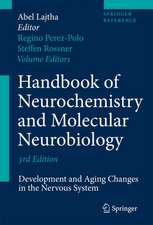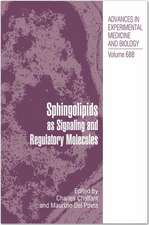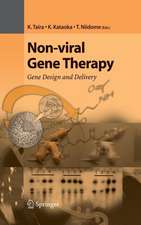Handbook of Neurochemistry and Molecular Neurobiology: Neurotransmitter Systems
Editat de Abel Lajtha, Sylvester E. Vizien Limba Engleză Hardback – 14 apr 2008
Preț: 1236.38 lei
Preț vechi: 1507.77 lei
-18% Nou
Puncte Express: 1855
Preț estimativ în valută:
236.58€ • 247.67$ • 195.75£
236.58€ • 247.67$ • 195.75£
Carte tipărită la comandă
Livrare economică 05-19 aprilie
Preluare comenzi: 021 569.72.76
Specificații
ISBN-13: 9780387303512
ISBN-10: 0387303510
Pagini: 465
Ilustrații: X, 465 p.
Dimensiuni: 170 x 244 x 23 mm
Greutate: 0.98 kg
Ediția:3rd ed. 2008
Editura: Springer Us
Colecția Springer
Locul publicării:New York, NY, United States
ISBN-10: 0387303510
Pagini: 465
Ilustrații: X, 465 p.
Dimensiuni: 170 x 244 x 23 mm
Greutate: 0.98 kg
Ediția:3rd ed. 2008
Editura: Springer Us
Colecția Springer
Locul publicării:New York, NY, United States
Public țintă
ResearchDescriere
The brain is the organ that collects information from the environment, processes and stores the information, and generates behavior as and when needed. In essence, the brain makes us who we are. For this reason, understanding the biology of brain function is a great challenge and a major goal of modern science. The brain is one of the last great frontiers in science, and the unraveling of its mysteries is comparable in complexity to efforts in space exploration. Therefore, it was not a surprise that the U.S. Congress proclaimed the 1990s the ‘‘Decade of the Brain,’’ a movement also introduced by several other countries, thereby giving a chance for neuroscientists to focus on this topic and to have better conditions for their research. A fundamental goal of neuroscience is to understand how neurons generate behavior and the pathophysiology of different mental and neurological diseases.
This requires, among other things, information about where these neurons are located, how they are connected, and how they communicate with each other in various physiological and pathophysiological conditions. At the end of the nineteenth century, the great neuroanatomist Santiago Ramon y Cajal recognized that neurons are the individual signaling elements of the brain. In this book, we focus on these nerve cells of the brain and the chemical molecules that allow them to talk to each other. The discovery of intercellular communication through endogenous molecules is a milestone in the history of science. It makes the brain a unique organ. Our aim is to describe recent discoveries about the basic operations of the brain and to provide an introduction to the adaptations for specific types of information processing. For example, at a chemical synapse, the presynaptic terminal liberates a transmitter substance that acts on the postsynaptic process. Thus, a synapse converts a presynaptic electrical signal into a chemical signal and back into a postsynaptic electrical signal.
Current experimental evidence indicates that this assumption needs to be enlarged. Neurons can communicate in a widespread but still organized mode: transmitters released into the extracellular space may have effects on distant extrasynaptic receptors, exerting a tonic effect. Neurons are able to release their transmitters locally into the extracellular space, where the transmitter diffuses slowly over some distance and influences many other neurons. The notion that the amount of transmitter released by an effective action potential arriving at the nerve terminal is not constant but can be modulated by the chemical environment in the vicinity of the release site is now well accepted, as also the effect of transmitters on postsynaptic sites.
This requires, among other things, information about where these neurons are located, how they are connected, and how they communicate with each other in various physiological and pathophysiological conditions. At the end of the nineteenth century, the great neuroanatomist Santiago Ramon y Cajal recognized that neurons are the individual signaling elements of the brain. In this book, we focus on these nerve cells of the brain and the chemical molecules that allow them to talk to each other. The discovery of intercellular communication through endogenous molecules is a milestone in the history of science. It makes the brain a unique organ. Our aim is to describe recent discoveries about the basic operations of the brain and to provide an introduction to the adaptations for specific types of information processing. For example, at a chemical synapse, the presynaptic terminal liberates a transmitter substance that acts on the postsynaptic process. Thus, a synapse converts a presynaptic electrical signal into a chemical signal and back into a postsynaptic electrical signal.
Current experimental evidence indicates that this assumption needs to be enlarged. Neurons can communicate in a widespread but still organized mode: transmitters released into the extracellular space may have effects on distant extrasynaptic receptors, exerting a tonic effect. Neurons are able to release their transmitters locally into the extracellular space, where the transmitter diffuses slowly over some distance and influences many other neurons. The notion that the amount of transmitter released by an effective action potential arriving at the nerve terminal is not constant but can be modulated by the chemical environment in the vicinity of the release site is now well accepted, as also the effect of transmitters on postsynaptic sites.
Cuprins
STRUCTURAL ORGANIZATION OF MONOAMINE AND ACETYLCHOLINE NEURON SYSTEMS IN THE RAT CNS – L. Descarries and N. Mechawar.- BRAIN NEURONS PARTLY EXPRESSING MONOAMINERGIC PHENOTYPE: DISTRIBUTION, DEVELOPMENT, AND FUNCTIONAL SIGNIFICANCE IN NORM AND PATHOLOGY – M. V. Ugrumov.- IN VIVO IMAGING OF NEUROTRANSMITTER SYSTEMS WITH PET – B. Gulyás, C. Halldin, and B. Mazière.- SYNAPTIC AND NONSYNAPTIC RELEASE OF TRANSMITTERS – E. S. Vizi and B. Lendvai.- CHOLINERGIC TRASMISSION - B. Lendvai.- MOLECULAR GENETICS OF BRAIN NORADRENERGIC NEUROTRANSMISSION – R. Meloni.- DOPAMINE AND THE DOPAMINERGIC SYSTEMS OF THE BRAIN – L. G. Harsing, Jr.- 5-HYDROXYTRYPTAMINE IN THE CENTRAL NERVOUS SYSTEM – A. C. Dutton and N. M. Barnes.- GABA NEUROTRANSMISSION: AN OVERVIEW – A. Schousboe and H. S. Waagepetersen.- ATP-MEDIATED SIGNALING IN THE NERVOUS SYSTEM – B. Sperlágh.- ADENOSINE NEUROMODULATION AND NEUROPROTECTION – R. A. Cunha.- REGULATION OF AMPA RECEPTORS BY METABOTROPIC RECEPTORS AND RECEPTOR TYROSINE KINASES: MECHANISMS AND PHYSIOLOGICAL ROLES – A. L. Carvalho, M. V. Caldeira, A. R. Gomes, A. P. Carvalho, and A. B. Duarte.- TAURINE IN NEUROTRANSMISSION – P. Saransaari and S. S. Oja.- THE ENDOCANNABINOID SYSTEM – B. S. Basavarajappa, R. Yalamanchili, T. B. Cooper, and B. L. Hungund.- E PROSTANOID RECEPTORS IN BRAIN PHYSIOLOGY AND DISEASE – C. D. Keene, P. J. Cimino, R. M. Breyer, K. S. Montine, and T. J. Montine.- NITRIC OXIDE AND OTHER DIFFUSIBLE MESSENGERS – J. P. Kiss.- MOLECULAR ORGANIZATION AND REGULATION OF GLUTAMATE RECEPTORS IN DEVELOPING AND ADULT MAMMALIAN CENTRAL NERVOUS SYSTEMS – E. Molnár.- SYMPATHETIC AND PEPTIDERGIC INNERVATION: MAJOR ROLE AT THE NEURAL-IMMUNE INTERFACE – I. J. Elenkov, A. Tagliani.
Caracteristici
Aims to describe recent discoveries about the basic operations of the brain
Provides an introduction to the adaptations for specific types of information processing
The brain is one of the last great frontiers in science
Provides an introduction to the adaptations for specific types of information processing
The brain is one of the last great frontiers in science












